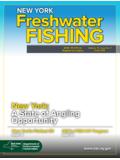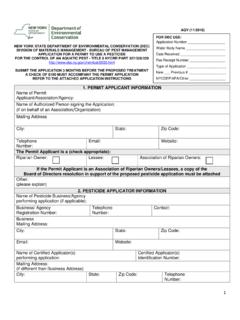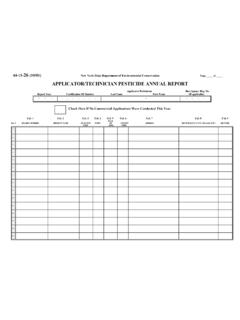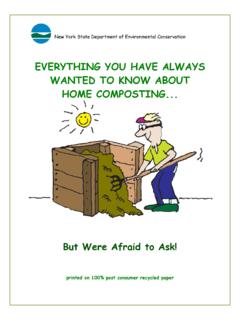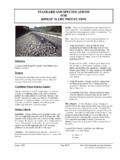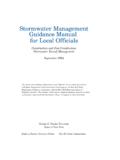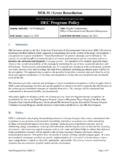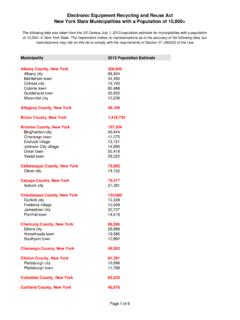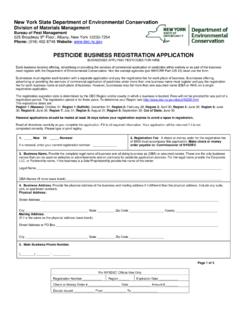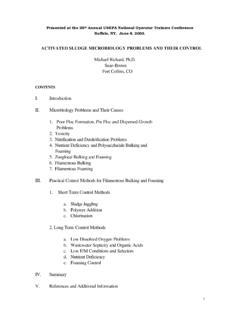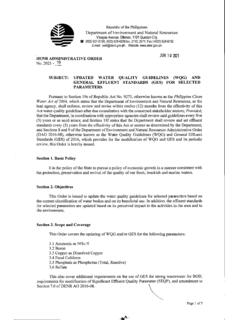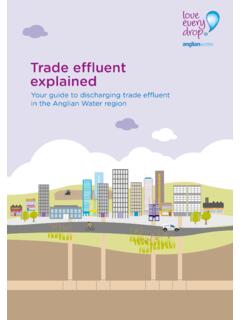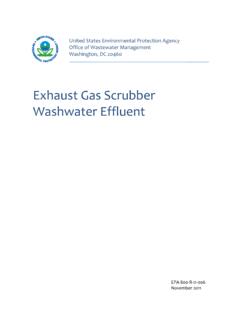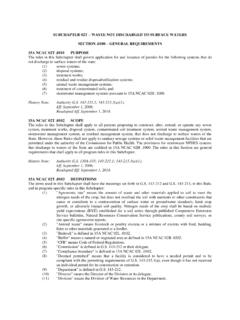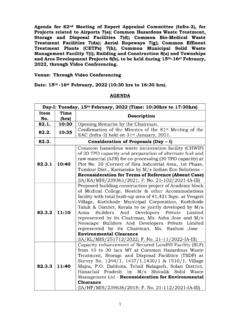Transcription of Division of Water Technical and Operational Guidance ...
1 1M E M O R A N D U M** N O T I C E **This document has been developed to provide Department staff with Guidance onhow to ensure compliance with statutory and regulatory requirements, includingcase law interpretations, and to provide consistent treatment of similar document may also be used by the public to gain Technical Guidance andinsight regarding how the department staff may analyze an issue and factors intheir consideration of particular facts and circumstances. This Guidance documentis not a fixed rule under the State Administrative Procedure Act section 102(2)(a)(i).Furthermore, nothing set forth herein prevents staff from varying from thisguidance as the specific facts and circumstances may dictate, provided staff'sactions comply with applicable statutory and regulatory requirements. Thisdocument does not create any enforceable rights for the benefit of any Date:October 22, 1993 Reissued Date: JUNE 1998TO:Bureau Directors, Regional Water Engineers, Section ChiefsSUBJECT: Division of Water Technical and Operational Guidance Series ( )AMBIENT Water quality STANDARDS AND Guidance VALUESAND GROUNDWATER effluent LIMITATIONS(Originator - John Zambrano/Scott Stoner)PURPOSEThe primary purpose of this document is to provide a compilation of ambient Water qualityguidance values and groundwater effluent limitations for use where there are no standards(in 6 NYCRR ) or regulatory effluent limitations (in ).
2 For the convenience of thereader, the standards in and groundwater effluent limitations in are included inthis document. The values in this document ( Guidance and regulatory) are used inDepartment programs, including the SPDES permit document combines and revises the previous editions of TOGS (ambient values)and (groundwater effluent limitations). The main reason for the revision is to includerevised and added ambient standards and effluent limitations resulting from the amendmentsto 6 NYCRR Parts 700 - 706, effective March 12, 1998. Ambient Guidance values are alsoadded for over 100 substances, largely based on the application of the Principal OrganicContaminant (POC) value to surface waters classified as sources of Water TOGS presents Division of Water ambient Water quality standards and Guidance valuesand groundwater effluent limitations. The authority for these values is derived from Article17 of the Environmental Conservation Law and 6 NYCRR Parts 700-706, Water TOGS is divided into two Parts.
3 Part I describes and lists ambient standards andguidance values. Part II describes and lists groundwater effluent the reader may be tempted to turn immediately to the tables containing the ambientor effluent values, the following cautionary note is important: Many substances for whichthere are standards, Guidance values and effluent limitations are not individually listed oridentified in the tables, but are included as part of group entries such as Principal OrganicContaminant. A careful reading of the text of Parts I and II is needed to ensure proper useof this OF CONTENTSTITLE PAGEPART I AMBIENT Water quality STANDARDS AND Guidance Explanation of Ambient Water quality Standards and Guidance How to Locate Ambient Standard or Guidance Development, Interpretation and Use of Ambient Standards and Guidance 1 New York Ambient Water quality Standards and 2 Explanation of Basis Codes in Table 3 Partial List of Substances Not Regulated by the Principal Organic Contaminant (POC) Groundwater 4 Definition for Principal Organic Contaminant II GROUNDWATER effluent Groundwater effluent Limitations (Class GA).
4 80C. Implementation of Groundwater effluent 5 New York State Groundwater effluent Limitations (Cl ass GA)..82 INDEX TO PARTS I AND II (BY CAS NO.)..1004 PART I AMBIENT Water quality STANDARDS AND Guidance VALUESA mbient Water quality standards and Guidance values for toxic and non-conventionalpollutants are presented in Table 1. This Table includes all of the Division 's numericalstandards and Guidance values established as of the date of this document exceptstandards for coliforms and dissolved oxygen. The reader is referred to Part 703 for theexcepted numerical standards and for the Department s narrative Water quality A of this Part provides an explanation of ambient Water quality standards andguidance values in the format of the column headings in Table 1. Section B, relying onthe background of Section A, provides a procedure to help determine whether or not thereis a standard or Guidance value for a particular substance.
5 Included in this section areinstructions on determining the applicability of the POC general groundwater standard tospecific substances. Section C provides Guidance on certain aspects of development,interpretation and use of standards and Guidance EXPLANATION OF AMBIENT Water quality STANDARDS AND GUIDANCEVALUESA mbient Water quality standards and Guidance values are presented in Table 1. Table 1includes columns for Substance (CAS No.), Water Classes, Standard, GuidanceValue, Type and Basis Code. This section describes these terms. Standards andguidance values are described first to facilitate and Guidance ValueStandards and Guidance values are ambient Water quality values that are set toprotect the state's waters. They both are derived according to scientific proceduresthat are in regulation (6 NYCRR Part 702).A standard is a value that has been promulgated and placed into regulation. Thestandards for the surface Water and groundwater classes are extracted from Part703 of Title 6.
6 Surface Water and groundwater standards were last revisedeffective March 12, Guidance value may be used where a standard for a substance or group ofsubstances has not been established for a particular Water class and type of value(section ). All Guidance values as of the date of this document are listed inTable 1 of this and Guidance values are the maximum allowable concentration in unitsof ug/L, unless otherwise indicated. Where standards or Guidance values areexpressed as a function of hardness, hardness is in units of parts per million(ppm), expressed as calcium carbonate, and the resulting value is in ug/L. Also,in such hardness functions, the term "exp" represents the base e exponentialfunction. 5"ND" means a non-detectable concentration by the approved analytical methodsreferenced in section general organic Guidance value, described in , is misunderstood bysome. This value does not automatically apply in the absence of a standard orspecific Guidance value.
7 For this value to be applied to an individual substance,the Department must determine that certain toxicological data requirements havebeen met. As of the date of this TOGS, the only substances for which the Divisionhas made this determination are listed in Table (CAS No.)The substance or group of substances (entry) for which a standard or guidancevalue has been derived is presented in this column in alphabetical order. TheChemical Abstract Service Registry (CAS) Number(s) are given, where applicable,to provide positive identification. Because a substance may be known by namesother than the one used in this document, identification of the CAS number can beuseful for locating the substance. An index of CAS numbers is provided at the endof the entries fit into one of three categories, as described below. For each suchentry, a Remark will indicate whether the standard(s) or Guidance value(s) applyto the sum of the substances or to each substance of Group Entriesa.
8 Where the entry consists of two or more specific substances, with or withoutCAS Numbers ( : Aldrin and Dieldrin), the entry includes only the specificsubstances Where the entry is the name of a group of substances, with CAS numberslisted ( : Dichlorotoluenes), the entry includes only those substances forwhich the CAS Numbers are Where the entry is the name of a group of substances, without CAS Numbers( : Principal organic contaminant), the entry includes all substances thatbelong to the group, unless otherwise noted. The specific substances in thegroup may not be listed in the entry or the index. A determination of thespecific substances encompassed by the standard(s) or Guidance value(s),therefore, may be principal organic contaminant (POC) standard for groundwater is thelargest and most complex of this third type of group entry. It is a generalstandard that applies individually to a virtually unlimited number of substancesin six chemical classes.
9 Because of the importance of this generalgroundwater standard, instructions for determining its applicability to specificsubstances are included in Section C, Classes and TypeStandards and Guidance values are developed for specific classes of fresh andsaline surface waters and fresh groundwaters for protection of the best usesassigned to each class. Best uses are described in Part 701. Standards andguidance values are further designated as to "Type." Values for protection ofsources of drinking Water are designated Health ( Water Source) and noted byH(WS). Similarly, values for protection of human consumers of fish are designatedas Health (Fish Consumption) and noted by H(FC). Values for protection ofaquatic life from chronic effects are designated Aquatic (Chronic) and noted asA(C). Values for protection of aquatic life from acute effects are designatedAquatic (Acute) and noted as A(A).
10 Values for protection of wildlife are designatedas Wildlife and noted as W. Values for protection from aesthetic considerationsare designated as Aesthetic and noted as E. Designation of the Type of valuedetermines the applicability of section , which concerns derivation ofguidance summary description of best usage protections, Water classes and type of valuesrelated to toxic pollutants is presented below. The groupings of Water Classes andType presented for the summary description are those that frequently appear inTable 1. A complete description of the Water classifications is provided in Part Classes TypeProtection ForA, A-S, AA, AA-SH(WS)Source of Drinking Water (surface Water )GAH(WS)Source of Drinking Water (groundwater)A, A-S, AA, AA-S, B, C, DH(FC)Human Consumption of Fish (fresh waters)SA, SB, SC, I, SDH(FC)Human Consumption of Fish (saline waters)A, A-S, AA, AA-S, B, CA(C)Fish Propagation (fresh waters)A, A-S, AA, AA-S, B, C, DA(A)Fish Survival (fresh waters)SA, SB, SC, IA(C)Fish Propagation (saline waters)SA, SB, SC, I, SDA(A)Fish Survival (saline waters)A, A-S, AA, AA-S, B, C, DWWildlife Protection (fresh waters)SA, SB, SC, I, SDWW ildlife Protection (saline waters)A, A-S, AA, AA-S, B, C, D, GAEA esthetic (fresh waters)SA, SB, SC, I, SDEA esthetic (saline waters)

